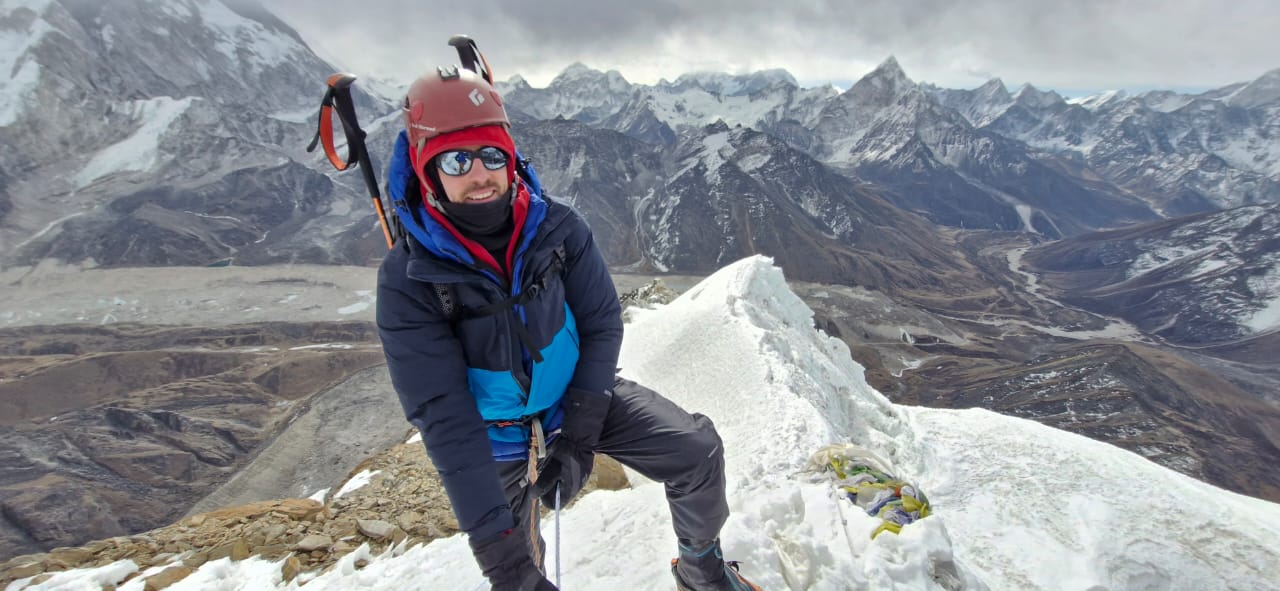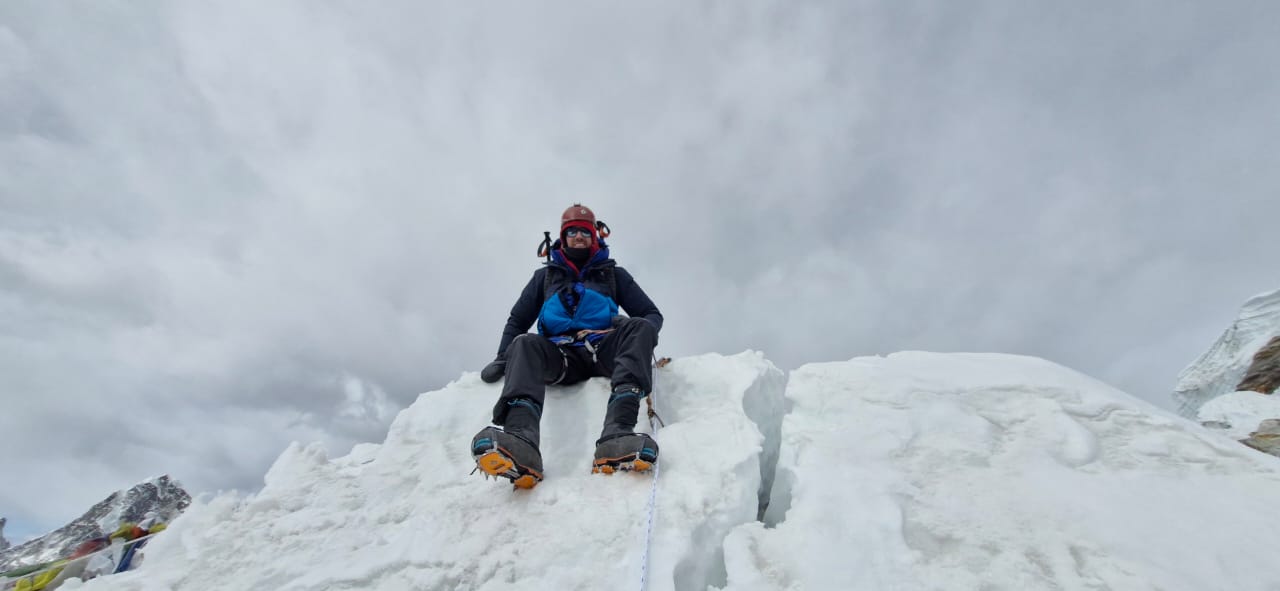LOBUCHE PEAK CLIMBING 9 DAYS
Lobuche Peak Climbing is nine days of sheer mountaineering pleasure and is the ideal trip for anyone looking to combine moderate trekking with some technical mountaineering and really get a taste of high alpine mountaineering. Peaking at 6,119 meters, Lobuche East is one of Tibet’s most sought-after trekking peaks, a perfect challenge to help you achieve impressive height and a more technical climb for trekkers who only have a few days to spare in the Everest region.
The trek starts with a 35-minute mountain flight to Lukla from Kathmandu, the seventy-five-minute flight offers you to close look at beautiful, bright white mountains flying above the deep valleys and relatively close in the distance snow-capped peaks. From Lukla, the trek begins to Phakding, cutting through rhododendron woods and Sherpa villages along the glacial Dudh Koshi River.
The second day, the trail climbs steadily to Namche Bazaar, the Sherpa hub teetering at 3,440 meters (11,286 feet). A necessary acclimatization day comes next, offering the opportunity to visit museums or to hike up to the Everest View Hotel for your initial panoramic views of Mount Everest and the adjacent mountain range.
The long push into the Khumbu takes you to the remote and culturally rich village of Pangboche, nestled among rugged mountains. It gains Ama Dablam Base Camp, a brief but worthwhile acclimatization hike which offers one of the most beautiful views in the Khumbu.
The trail then climbs higher to Thukla before eventually making your final ascent to Lobuche High Camp (5,600m), your base for the summit. The evening is dedicated to roping and equipment preparation, and a quick review of rope systems and climbing technique by the guides. Summit day starts early, with climbers climbing steep, icy slopes while rappelling, wearing crampons and wielding ice axes to get to the snowy summit ridge. At the summit, the exposure takes in Everest, Lhotse, Nuptse, Makalu, and Ama Dablam—a 360-degree orchestration of Himalayan behemoths.
The following day, you descend to Thukla, en route to Pheriche, where the pace slackens. From here, a helicopter shuttles you back to Lukla, offering one final aerial perspective of soaring mountains you’ve just conquered. Your adventure comes to an end with a short domestic flight back to Kathmandu.
This 9-day Lobuche Peak ascent is for experienced trekkers or wannabe climbers who would like a stripped-back, quick ascent with good acclimatization and a safe descent. It has everything: technical challenge, cultural immersion, and unforgettable Himalayan beauty.
ITINERARY
Day 1 : Fly to Lukla (2,804m) & Trek to Phakding (2,640m) Duration: 4–5 hours.
Your journey begins with an exciting 35-minute flight from Kathmandu to Lukla, one of the world’s most thrilling airports. After landing in Lukla, you begin your trek towards Phakding, following the Dudh Koshi River. This relatively easy day takes you through pine forests, past traditional Sherpa villages, and across suspension bridges, offering a perfect introduction to the beautiful landscape of the Everest region.
Day 2 : Trek from Phakding to Namche Bazaar (3,440m) Duration: 5–6 hours.
On this day, you will trek through dense forests and cross several suspension bridges. As you ascend, the route gradually gets steeper, and the first glimpses of Mount Everest appear. After a challenging but rewarding climb, you will arrive in Namche Bazaar, the vibrant Sherpa capital, where you’ll have a spectacular view of Mount Everest in the distance.
Day 3 : Acclimatization Day at Namche Bazaar.
This day is dedicated to acclimatization. It’s crucial for adjusting to the high altitude to help prevent altitude sickness. You will hike up to the Everest View Hotel or the nearby museum, offering you panoramic views of Everest, Ama Dablam, Lhotse, and many other peaks. This rest day is essential to help your body adjust to the increasing altitude before continuing your climb.
Day 4 : Trek from Namche to Pangboche (3,930m) Duration: 5–6 hours.
Today, the trek takes you from Namche to Pangboche, passing through traditional Sherpa villages. As you climb, you’ll pass the famous Tengboche Monastery before reaching Pangboche, a village with ancient religious significance. From here, you will enjoy stunning views of Ama Dablam, one of the most iconic peaks in the Everest region.
Day 5 : Acclimatization Day at Pangboche – Hike to Ama Dablam Base Camp (4,600m) Duration: 4–5 hours.
After a rest day in Pangboche, you will take a hike up to the Ama Dablam Base Camp. This acclimatization hike will help your body adjust to the high altitude while offering incredible views of Ama Dablam. The hike itself is a beautiful experience, surrounded by snow-capped peaks, glaciers, and dramatic alpine terrain.
Day 6 : Trek from Pangboche to Thukla (4,620m) Duration: 5–6 hours.
The trek today takes you through the rugged terrain towards Thukla. Along the way, you will continue to witness awe-inspiring views of Everest and other surrounding peaks. Thukla is a small settlement located near the base of the Lobuche Peak, and it serves as an important stop on your journey to higher altitudes.
Day 7 : Trek from Thukla to Lobuche High Camp (5,600m) Duration: 5–6 hours.
Today, you will ascend from Thukla to Lobuche High Camp. The path climbs steadily through rocky terrain and offers some of the most spectacular views of the surrounding peaks. Lobuche High Camp is your base for the summit attempt the next day, and you will take time to prepare and check all your climbing gear before the challenging summit push.
Day 8 : Summit Lobuche Peak (6,119m) & Descend to Thukla Duration: 9–10 hours.
Summit day is the most demanding, as you climb from the High Camp to the top of Lobuche Peak. The climb involves navigating snow and ice-covered terrain, with sections requiring fixed ropes and the use of crampons and ice axes. Once at the summit, you will be rewarded with incredible panoramic views of the surrounding Himalayan peaks, including Everest, Lhotse, Nuptse, and Makalu. After reaching the summit, you will begin your descent back to Thukla to rest.
Day 9 : Trek to Pheriche, Helicopter Fly to Lukla & Flight to Kathmandu Duration: 4–5 hours.
On the final day of your trek, you will descend from Thukla to Pheriche. From here, you will take a helicopter flight back to Lukla, saving you the long and tiring trek back down. From Lukla, you will catch a flight back to Kathmandu, bringing an end to your incredible journey through the Everest region.
SERVICES
Costs Included in Your Package
- Domestic Airport Pick-Up and Drop-Off: Private car or jeep transfer from/to the airport for your convenience and comfort.
- Meals During the Trek: Three nutritious meals per day (breakfast, lunch, and dinner), including fresh fruit served each evening after dinner.
- Scenic Helicopter Transfer: Shared helicopter flight from Pheriche to Lukla, offering a spectacular aerial view of the Himalayas.
- Accommodation: Comfortable trekking lodge (tea house) stays during the trek, and tented camp accommodation during the Lobuche Peak climbing session.
- Permits and Entry Fees: All necessary paperwork, including the Sagarmatha National Park Entry Permit and Khumbu Pasang Lhamu Rural Municipality fees.
- Flights and Transfers: Round-trip domestic flights (Kathmandu–Lukla–Kathmandu via Ramechhap) with private airport transfers and applicable airport taxes.
- Experienced Trekking and Climbing Guide: An English-speaking, government-licensed guide who is friendly, knowledgeable, well-trained, and fully insured, covering all his expenses, including salary, food, accommodation, transport, and insurance.
- Lobuche Peak Climbing Permit: Official permit for climbing Lobuche Peak.
- Sherpa Porters: Reliable, helpful Sherpa porters (one for every two trekkers) equipped with proper safety and walking gear. Their salary, meals, accommodation, and insurance are covered.
- Medical Support: A Comprehensive first aid kit is available throughout the trek for your safety and peace of mind.
- Emergency Helicopter Arrangement: Coordination of emergency helicopter evacuation (covered by your personal travel insurance, if required).
- Essential Trekking Gear (On Loan): Complimentary use of sleeping bag, down jacket, duffel bag, and walking poles (to be returned after the trek).
- Exclusive Souvenirs: Sherpa Expedition & Trekking T-shirt and a trip achievement certificate upon successful trip completion.
- Health Monitoring: Daily use of an oxygen meter to monitor your pulse, oxygen saturation, and heart rate—crucial for detecting early signs of Altitude Mountain Sickness (AMS).
- Assistant Guide: An additional assistant guide will be provided for groups of 8 or more trekkers to ensure safety and personalized attention.
- Government Fees and Taxes: All government taxes and official expenses are included.
Costs Excluded from Your Package
- Meals in Kathmandu: Lunch and dinner while staying in Kathmandu are not included.
- Hotel Accommodation in Kathmandu: Accommodation in Kathmandu before or after the trek is not covered.
- Nepal Entry Visa: The Nepal visa fee is not included. Visas are available on arrival at Tribhuvan International Airport:
- $30 USD for 15 days
- $50 USD for 30 days
- $125 USD for 90 days
- Travel & Medical Insurance: Personal travel and medical insurance (mandatory for trekking and climbing).
- International Airfare: Flights to and from Nepal are not included.
- Personal Expenses: Any personal spending, such as souvenirs, laundry, and snacks.
- Drinks & Snacks During the Trek: Alcoholic and non-alcoholic beverages (including tea, coffee, soup, hot chocolate, cocoa, bottled water), as well as any extra food items purchased along the way or at tea houses (e.g., additional meals, snacks, desserts like chocolate, cake, pudding, etc.).
- Extras at Tea Houses: Charges for hot showers, Wi-Fi, and battery charging at trekking lodges are not included.
- Tips: Gratuities for guides, porters, and drivers (tipping is customary and appreciated).
- Excess Baggage Fees: Extra baggage over 10 kg on the Lukla flight may incur additional fees.
- Early Return from Trek: In case of an early return due to illness or any unforeseen reason, the cost of unused services (flights, accommodations, meals, etc.) is non-refundable. Any additional expenses in Kathmandu (hotel, meals, etc.) will be your responsibility.
EQUIPMENTS
You’ll carry your personal gear and share some group equipment, so pack light with layered, weather-appropriate clothing—avoid cotton and choose breathable, insulating fabrics. A windproof duffle (provided and carried by porters) and water are included. Non-trekking items can be stored in Kathmandu. Sherpa Expedition & Trekking supplies all essential expedition gear.
Upper Body:
- Base Layers: Moisture-wicking and quick-drying shirts and thermal tops.
- Insulation Layers: Fleece or down jackets to provide warmth.
- Waterproof Shell Jacket: A durable and breathable jacket to protect against wind and rain.
- Softshell Jacket: A lightweight and water-resistant jacket for added protection.
- Climbing Harness: A comfortable harness to secure yourself to the rope.
- Helmet: A strong and well-fitting helmet to protect your head from falling objects.
- Gloves: A combination of lightweight liner gloves and insulated gloves or mittens for warmth and dexterity.
- Buff or Neck Gaiter: To protect your neck and face from cold and wind.
- Sunglasses: Polarized and UV-protected sunglasses to shield your eyes from the sun and snow glare.
- Goggles: Ski or mountaineering goggles for added eye protection in extreme weather conditions.
Lower Body:
- Base Layers: Moisture-wicking and quick-drying thermal bottoms.
- Insulation Layers: Fleece or insulated pants for added warmth.
- Waterproof Shell Pants: Durable and breathable pants to protect against wind, rain, and snow.
- Softshell Pants: Lightweight and water-resistant pants for added protection.
- Mountaineering Boots: Sturdy and insulated boots designed for snow and ice.
- Crampons: Attachable spikes that provide traction on icy terrain.
- Gaiters: Waterproof and breathable gaiters to keep snow out of your boots.
- Socks: A combination of moisture-wicking liner socks and thick, warm mountaineering socks.
Other Essential Items:
- Backpack: A spacious and sturdy backpack to carry your climbing gear and personal belongings.
- Sleeping Bag: A warm and lightweight sleeping bag that can withstand sub-zero temperatures.
- Trekking Poles: Adjustable trekking poles for added stability and support.
- Headlamp: Essential for climbing in low-light or dark conditions.
- Water Bottles: Insulated water bottles to keep your water from freezing.
- Sunscreen: High SPF sunscreen to protect your skin from the strong sun at high altitudes.
- First Aid Kit: A comprehensive first aid kit with essential medications and supplies.
- Climbing Snacks: Energy bars, nuts, and other lightweight snacks for quick fuel during the climb.
It is important to invest in high-quality gear and ensure that everything fits properly and is in good condition. Additionally, consult with experienced climbers or a professional guide to ensure you have all the necessary gear and receive proper training on how to use it effectively and safely.
Note: Essential climbing equipment, including an ice axe, crampons, climbing boots, harness, helmet, safety rope, ascender (jumar), and carabiner, can be hired in Dongboche. The total cost is approximately USD 120 per person for a complete set.
GOOD TO KNOW
📅 Best Time to Climb
The best time to climb Lobuche Peak is during the pre-monsoon (March to May) and post-monsoon (late September to November) seasons. During these months, the weather is typically stable, skies are clear, and visibility is excellent—ideal for both trekking and climbing. Spring brings colorful rhododendron blooms, while autumn offers crisp air and panoramic Himalayan views.
🧗♂️ Climbing Difficulty
Lobuche East is classified as a technical trekking peak, meaning it demands more than just basic hiking skills. The summit push includes steep snow and ice sections, the use of fixed ropes, and glacier crossings. Prior experience with crampons, ice axe, and rope work is highly recommended. This climb is best suited for trekkers with high-altitude experience or those who have completed a basic mountaineering course.
🎒 Required Gear
Climbers need a full set of mountaineering equipment, including insulated boots, crampons, harness, helmet, carabiners, belay devices, climbing rope, and an ice axe. Sleeping bags rated for extreme cold and down jackets are also essential. Most gear can be rented in Kathmandu if you don’t own it, but using well-fitted personal gear is always preferable for safety and comfort.
💪 Fitness Level
A high level of physical and mental fitness is essential for this climb. You should be able to walk 6–8 hours per day, including uphill ascents at high altitude. Summit day can stretch to 10+ hours and will test your endurance. Cardio conditioning, strength training, and hiking experience at altitude are vital preparation components.
🌐 Connectivity
While Wi-Fi and mobile signal are available in lower sections like Namche Bazaar and Pangboche, the signal gets weaker or disappears entirely as you approach High Camp. Be prepared to disconnect from the internet for a few days, especially during the summit climb. For safety, guides often carry satellite phones or radios.
💊 Altitude Sickness
Climbing to over 6,000 meters poses risks of Acute Mountain Sickness (AMS). The itinerary includes proper acclimatization days in Namche and Pangboche, as well as gradual altitude gain. You should be familiar with symptoms like headache, nausea, and dizziness. Your guide will monitor your health closely, and altitude medication (e.g., Diamox) may be used if needed.
🛫 Helicopter Evacuation Option
A helicopter return from Pheriche to Lukla is included after the climb to reduce fatigue and save time. In case of medical emergencies or severe altitude sickness, helicopter rescue services are available throughout the region. Ensure you have travel insurance that covers high-altitude evacuation, as the cost can be significant.
🧳 Luggage & Porters
Your main luggage is carried by experienced porters, allowing you to trek with a light daypack holding essentials such as water, snacks, layers, and personal items. Porters are an integral part of the team, and respecting weight limits (usually 10–15 kg per duffel) helps ensure fair working conditions.
🛏 Accommodation
During the trek, you’ll stay in locally run teahouses, offering cozy rooms, hearty meals, and a glimpse into Sherpa hospitality. These teahouses typically provide twin-sharing rooms, shared toilets, and heated dining areas. At High Camp, climbers sleep in expedition tents, with all meals prepared by the support crew.
📄 Permits Needed
To climb Lobuche Peak legally, you must obtain the Lobuche Peak Climbing Permit, along with the Sagarmatha National Park Entry Permit and the TIMS (Trekkers’ Information Management System) Card. These are arranged by your trekking agency and are required at multiple checkpoints throughout the region.
MAP
PHOTOS/Videos
Departures
Select a departure month
Fill out the form below and a Travel Expert will reach out to create your perfect tour.
FAQS
How difficult is Lobuche Peak to climb?
Lobuche East is considered a technical trekking peak, which means it requires more than just trekking experience. The summit climb involves glacier travel, steep snow slopes, and the use of fixed ropes, crampons, and an ice axe. It’s recommended for those who have previous high-altitude trekking or basic mountaineering experience.
What is the altitude of Lobuche Peak?
The summit of Lobuche East stands at 6,119 meters (20,075 feet) above sea level. This makes it one of the more demanding trekking peaks in Nepal, offering panoramic views of Everest, Lhotse, Nuptse, and more.
Do I need previous climbing experience?
While previous mountaineering experience is helpful, it’s not mandatory. However, you should have experience trekking at high altitude and be comfortable using gear like crampons and harnesses. Pre-climb training at High Camp is usually provided by your guides.
What permits are required for this climb?
You’ll need the following permits:
Lobuche Peak Climbing Permit
Sagarmatha National Park Entry Permit
TIMS Card (Trekkers’ Information Management System)
Your trekking agency will usually handle all the paperwork on your behalf.
How many days does the Lobuche Peak expedition take?
The full expedition typically takes 8 to 10 days, depending on the itinerary. This includes acclimatization days, summit day, and a helicopter return from Pheriche or another nearby village to Lukla.
Is there a risk of altitude sickness?
Yes, altitude sickness is a risk on any Himalayan climb above 3,000 meters. The itinerary includes acclimatization days in Namche and Pangboche to minimize this. Your guide will monitor symptoms and carry a first aid kit and altitude medication.
What gear is needed for the climb?
You’ll need mountaineering essentials like crampons, ice axe, climbing harness, helmet, mountaineering boots, and appropriate clothing for cold conditions. Most of the technical gear can be rented in Kathmandu if you don’t bring your own.
What kind of accommodation is available?
During the trek, you’ll stay in traditional teahouses, which offer simple yet comfortable lodging. At High Camp before summit day, you’ll sleep in mountain tents, and meals will be provided by your expedition team.
How is the weather on Lobuche Peak?
Weather in the Himalayas is unpredictable, especially at higher altitudes. Expect cold temperatures, strong winds, and snow above 5,000 meters. Spring (March–May) and autumn (September–November) offer the most stable conditions.
Is helicopter evacuation included or available?
Most premium itineraries include a helicopter descent from Pheriche to Lukla after the summit for convenience and safety. Emergency helicopter evacuation is also available but must be covered by travel insurance that includes high-altitude rescue.
Latest Traveller’s Reviews
Travel experiences of our clients who recently returned from their trips.
100%
Based On 840 Reviews
Zbigniew Połoniewicz
Australia
September 17, 2024
A Life-Changing Adventure
My Chulu Far East Peak climbing experience with Sherpa Expedition was life-changing. The guides were exceptional—supportive, knowledgeable, and always there to help. They made sure we were well-prepared and safe during the trek. The stunning views and the thrill of reaching the summit were beyond words. I appreciated the attention to detail in logistics, meals, and accommodations, which contributed to a seamless experience. I left with amazing memories and new friends. I highly recommend Sherpa Expedition for an incredible climbing adventure!
George Bricks
Canada
September 17, 2024
Challenging Yet Rewarding Adventure
The Pisang Peak trek with Sherpa Expedition was a challenging yet rewarding adventure. Our guides were exceptional, providing constant support and motivation. They made sure we were well-acclimatized and prepared for the climb. The scenery was stunning, especially as we approached the summit, where the panoramic views took my breath away. I appreciated the attention to detail in logistics, from meals to accommodations. This trek was an unforgettable experience, and I highly recommend Sherpa Expedition for anyone ready to tackle Pisang Peak!
Ngagne Diambang
Hong Kong
September 16, 2024
Outstanding Service!
I can’t thank Sherpa Expedition & Trekking enough for the incredible service during my Everest Base Camp and Island Peak climb. Every detail was meticulously planned, and the guides were attentive to our needs. They provided great insights into the climbing techniques necessary for Island Peak. The scenery was beyond words, and each day was a new adventure. The encouragement from the team helped us reach the summit, and the celebration afterward was a highlight! I highly recommend this expedition for anyone ready for a challenge.
People Considering This Package Right Now Check availability


























